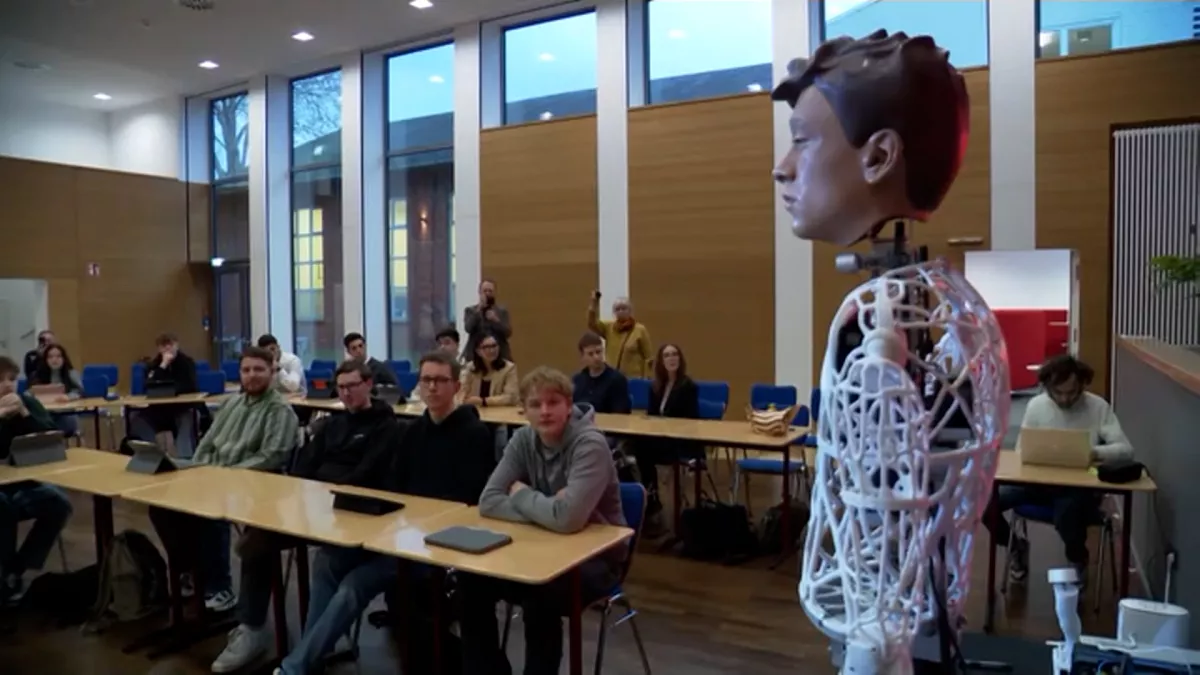
Robot teacher in German classroom
Robot Teacher Enters German Classrooms A New Era in Education Begins
In a bold and intriguing step toward the future of education, a German school has introduced a humanoid robot as part of its regular teaching staff, sparking both excitement and deep philosophical discussions about the role of artificial intelligence in the classroom. The robot, named “Elias,” has been developed with advanced AI capabilities, voice recognition, emotional feedback systems, and multilingual teaching functions. Designed by a team of robotics engineers and educational psychologists, Elias was deployed in a secondary school in North Rhine Westphalia to assist with language instruction, math tutoring, and interactive learning modules. The project, which began as a pilot funded by Germany’s Federal Ministry of Education and Research, aims to explore how AI can augment traditional teaching rather than replace it.
Elias is not just a talking machine it’s programmed with responsive software that allows it to recognize students by name, detect mood changes based on vocal cues and facial expressions, and tailor its lessons to suit individual learning styles. In a recent English language class, for example, Elias quizzed students on vocabulary through an interactive game, corrected pronunciation using real time feedback, and encouraged shy students with gentle affirmations and programmed empathy cues. Teachers observed that students who were typically disengaged or anxious became more involved, viewing Elias not as a disciplinarian but as a non judgmental assistant. While Elias doesn’t yet lead full lectures, it serves as a dynamic support tool, reinforcing lessons and facilitating personalized learning.
This development reflects a broader trend in educational technology, where AI is being embraced as a means to personalize education, bridge resource gaps, and prepare students for an increasingly digital world. Germany, known for its engineering prowess, has been gradually integrating AI into various sectors. However, its application in schools has been cautious and highly regulated. Elias represents one of the first real world classroom experiments with humanoid robots in Europe’s public education system. The German government's interest lies not only in boosting learning outcomes but also in fostering digital literacy and preparing future workers for an AI driven economy.
The response from students and parents has been largely positive, though not without skepticism. Younger students were quick to adapt to Elias, treating it with the same curiosity and respect they might give a new teacher. Some even expressed a preference for its “fairness” in testing and assessments, free from human bias. Parents, on the other hand, voiced a mix of hope and concern. While many welcomed the additional academic support especially in overcrowded classrooms others questioned if constant interaction with a machine could affect students’ social development or reduce human empathy in learning environments. Teachers have echoed these sentiments, insisting that robots must always serve as assistants rather than replacements.
Educators involved in the pilot program have emphasized the importance of maintaining the human element in teaching. “The robot is a tool, not a teacher,” explained one principal involved in the trial. “Our goal is not to automate education, but to make it more inclusive and responsive. Elias helps us manage large classes, provides customized support, and frees up teachers to focus on mentorship and deeper instruction.” The school has also set clear boundaries Elias does not discipline students, grade final exams, or initiate conversations about sensitive topics. Its role is strictly pedagogical and supplemental, guided by an ethical framework developed in consultation with psychologists and child development experts.
From a technological standpoint, Elias represents a leap forward in adaptive learning systems. Equipped with natural language processing, a machine learning algorithm that adapts based on student performance, and a real time feedback loop, Elias can “learn” how best to help individual students. For example, if a student struggles with grammar, the robot offers more examples and encourages practice through gamified tasks. If another student excels, Elias automatically raises the difficulty level to maintain engagement. Teachers receive weekly performance reports generated by Elias, which help them track progress, spot learning gaps, and design targeted interventions. This data driven approach has shown early signs of boosting classroom efficiency and academic performance.
The introduction of Elias also brings into focus a larger philosophical and ethical discussion What is the role of machines in human development? German sociologists and ethicists are closely watching the pilot, weighing concerns about digital dependence, privacy, and the commercialization of education. Critics argue that integrating robots too deeply into learning could create a transactional model of education, where creativity and emotional intelligence are overshadowed by metrics and automation. Others warn of a “digital divide” where only well funded schools can afford such technologies, exacerbating educational inequality. The government, in response, has mandated rigorous oversight and plans to publish a comprehensive impact assessment after the pilot phase concludes.
Looking ahead, the success of Elias could pave the way for a new generation of educational robots across Europe. Already, inquiries have come in from schools in Finland, the Netherlands, and Austria seeking to participate in future trials. Developers are also working on expanding Elias’s subject expertise, adding history, environmental science, and even art appreciation to its programming. There are ambitions to equip Elias with multilingual capabilities that could make it especially useful in immigrant and refugee education, where language barriers often limit access to learning. The long term vision is to create an AI teaching assistant that is not only efficient but culturally aware and emotionally intelligent.
In conclusion, the introduction of Elias the robot teacher in a German classroom marks a transformative moment in educational innovation. While it is still too early to declare the pilot a definitive success, early observations suggest that robots like Elias could complement traditional teaching in powerful and unexpected ways. By offering personalized learning, reducing teacher workload, and encouraging digital engagement, such AI tools could help shape a more inclusive and future ready education system. However, this transformation must be carefully managed, with clear ethical guidelines, equitable access, and a firm commitment to preserving the irreplaceable value of human interaction in learning. As Germany tests the boundaries of what machines can do in education, the world watches and learns.











